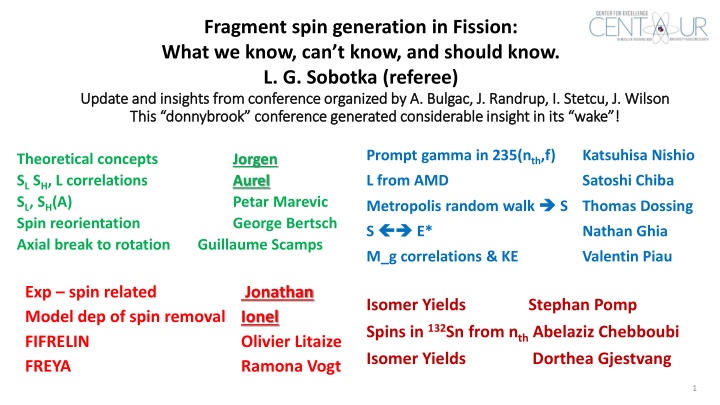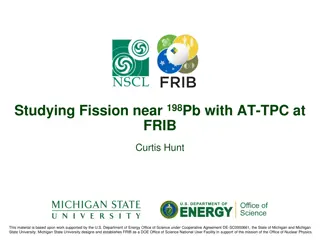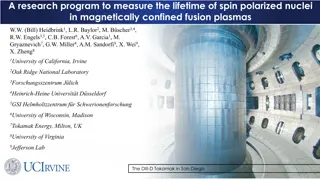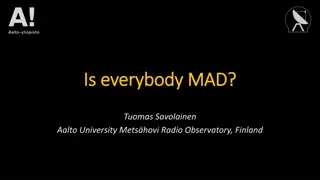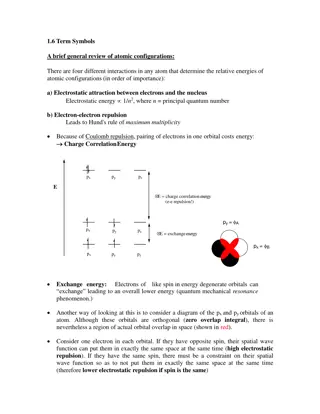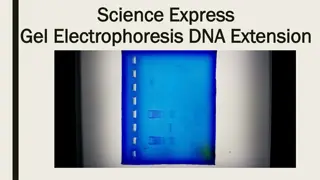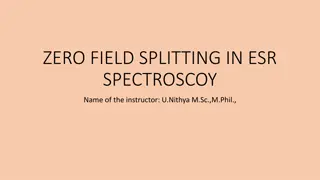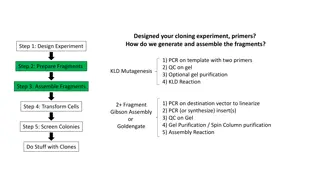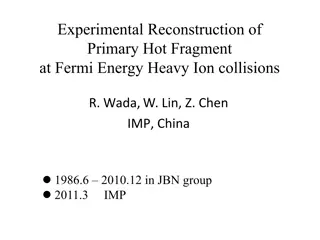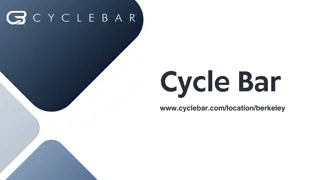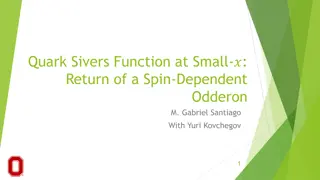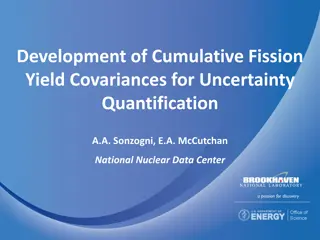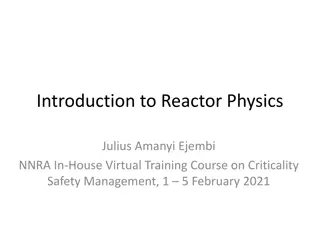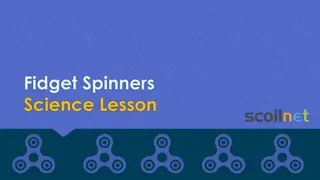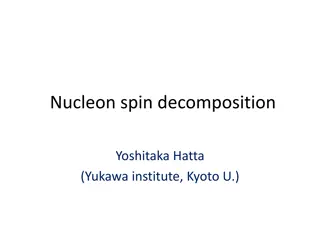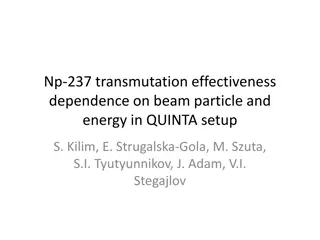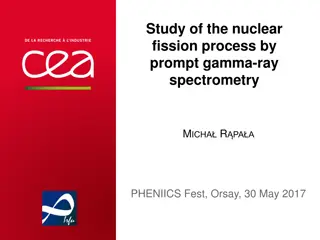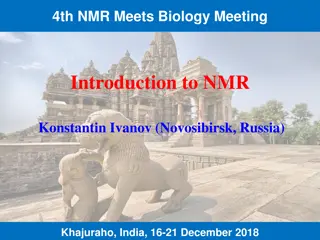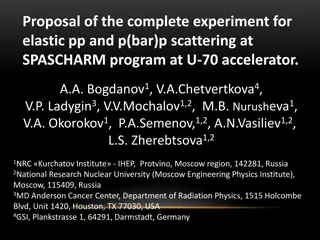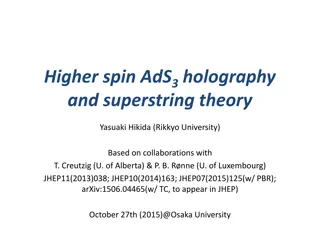Insights on Fragment Spin Generation in Fission: What We Know
Considerable insight was generated from a recent conference on fission, shedding light on crucial theoretical and experimental aspects. Key topics include angular momentum, fission-fragment spin references, and the dynamics of nuclear fission. Theoretical advancements like the TDSLDA model and superfluid DFT have contributed to our understanding of fission processes. Notably, the role of surface tension in driving fission and the successes of models like FREYA highlight the complexity and nuance of fission phenomena.
Download Presentation

Please find below an Image/Link to download the presentation.
The content on the website is provided AS IS for your information and personal use only. It may not be sold, licensed, or shared on other websites without obtaining consent from the author.If you encounter any issues during the download, it is possible that the publisher has removed the file from their server.
You are allowed to download the files provided on this website for personal or commercial use, subject to the condition that they are used lawfully. All files are the property of their respective owners.
The content on the website is provided AS IS for your information and personal use only. It may not be sold, licensed, or shared on other websites without obtaining consent from the author.
E N D
Presentation Transcript
Fragment spin generation in Fission: What we know, can t know, and should know. L. G. Sobotka (referee) Update and insights from conference organized by A. Bulgac, J. Randrup, I. Stetcu, J. Wilson Update and insights from conference organized by A. Bulgac, J. Randrup, I. Stetcu, J. Wilson This donnybrook conference generated considerable insight in its wake ! This donnybrook conference generated considerable insight in its wake ! Prompt gamma in 235(nth,f) L from AMD Metropolis random walk S E* Katsuhisa Nishio Theoretical concepts SL SH, L correlations SL, SH(A) Spin reorientation Axial break to rotation Guillaume Scamps Jorgen Aurel Petar Marevic George Bertsch Satoshi Chiba S Thomas Dossing Nathan Ghia M_g correlations & KE Valentin Piau Exp spin related Model dep of spin removal Ionel FIFRELIN FREYA Jonathan Isomer Yields Spins in 132Sn from nth Abelaziz Chebboubi Isomer Yields Stephan Pomp Olivier Litaize Ramona Vogt Dorthea Gjestvang 1
Conventional image of fission. (We may need a mental adjustment) Conventional image of fission. (We may need a mental adjustment) <SH/L>i ~ 10 hbar & s s ~ 0.4 < > -- ~ 1 hbar/n -- a few more hbar <SH/L>e ~ 6 hbar below entry SH + SL + L = S0 = 0 (252Cf) Most neutrons are kinematically focused Angular momentum is conserved 2
Pivotal fission-fragment spin references EXPERIMENT 1. Angular Momentum if primary products in fission of 252Cf, J. B. Wilhelmy, R. Cheifetz, R. C. Jared, S. G. Thompson, H. R. Bowman, and J. O. Rasmussen, PRC 5, 2041 (1972). 2. Angular distribution of specific gamma rays in 252Cf, A. Wolf and R. Cheifetz, PRC 13, 1952 (1976). 3. Angular correlations in the prompt neutron emission in . 252Cf, A. Chietere, Eur Phys. J. A 54, 98 (2018). 4. Angular momentum generation in nuclear fission, J. Wilson et at, Nature 590, (2021). THEORY 1. V. M. Strutinsky, Sov. Phys. JETP 10, 613 (1960). 2. J. R. Nix and W. J. Swiatecki, NP 71, 1 (1965). 3. J. O. Rasmussen et al, NPA 136, 465 (1969). 4. L. G. Moretto and R. P. Schmitt, PRC 21, 204 (1980) & LGM, Lecture 2, Varenna Conference 1979, LBL-9130. 5. P. Moller et al, Nature 409 , 785 (2001). 6. G. F. Bertsch, T. Kawano, and L. M. Robledo, PRC 99, 034603 (2019), Guillaume Scamps and GB, preprint. 7. J. Randrup, PRC 106, L051601 (2022), J. Randrup and Ramona Vogt, PRL 127, 062502 (2021) .. FREYA 8. A. Bulgac, PRL 128, 022501 (2022), PRC 106, 014624 (2022) .. TDSLDA (TD Superfluid DFT). 9. J. Chen, C. Ishizuka, and S. Chiba, AMD unpublished thesis, (2022). With apologies for omissions!! (I have a limited focus in this talk.) 3
Micro Micro- -Macro (FREYA) Macro (FREYA) TDSLDA TDSLDA - - TD & Superfluid (beyond BCS) DFT TD & Superfluid (beyond BCS) DFT Many and recent - successes FULLY MICROSCOPIC Spontaneous fission occurs with creepy, overdamped dynamics. One can ague that fission occurs because the decrease in surface tension (induced by internal excitation) drives up fissility [Wheeler s X == (Coulomb) / (2 Surface E)]. Many field defining success: Masses (FRLDM+SE), fission isomers (5+ shape dof), mass distributions, TKE, mean # neutrons, In Freya: shape evolution modeled by METROPOLIS Walk in a multi-d PES. Shape dependent level densities guide shape evolution. Mass(asy), mean # neutrons(asy) and spins (asy) & spin variances come out naturally. The exceedingly damped dynamics justifies the dynamics used In phenomenological models. (However the fragment KE s provided a rational decades ago.) But inertias are ad hoc, (to get TKE) AND angular momentum generation statistical. . model mobility Coefficients for rel;ative Excitation of phenomenological This is the (dynamical) theory Araceli is asking for. Yesterday. Superfluidity mediates shape changes. Two nucleons (generally) jump concertedly at level crossing with deformation. Even starting at the outer saddle, fission would not occur wo pairing. 4
Selected (Spin Selected (Spin- -Spin) CONCLUSIONS Spin) CONCLUSIONS What we know: 1. The spin saw tooth exists, is robust, and - like the neutron saw tooth & mass distribution, - is pinned by the heavy fragment. [JW] 2. There is little to no spin-spin (magnitude) correlation |SL| |SH| and fragment spins are independent of partner. [JW] 3. This was the a priori expectation [JR+RV FREYA] and posteriori explained by others |SL| |SH| independence [JR+RV,TD,AB|. 4. There is a huge difference in theory predictions for the SL SHvector correlations. [JR+RV and AB]. Old experiments say 2d but new experiments are (largely) silent. 5. a) IF fragment spins confined in 2d plane perpendicular to fission axis SL SH. b) IF fragment spins ~ random in 3d . SL strong SH. 6. 1-2 hbar CAN be obtained post-scission due to CoulEx. [GB + GS] This spin contribution is largely confined to have m = 0 (i.e. in plane perp to beam). 5
M M Jonathan Wilson (JW): new (below entry line) data Jonathan Wilson (JW): new (below entry line) data g g 1. Definitive spin saw-tooth Like Mass and <n> distributions Heavy fragment pins. 2. Dance partner irrelevant 3. Fluctuations in SH :SL uncorrelated, but why? n n Bethe, FG, ~ rigid I, E* ~ neck volume Note: The shell effects of importance are those for octopole/ pear /kissing shapes (Z ~ 54). 6
Ramona Vogt explained why why fragment spins are UN UNcorrelated 7
Ramona Vogts Clear explanation WB 8
Randrup Randrup: : Magnitude Independence. Magnitude Independence. My own Wriggling My own Wriggling- -Bending mode script Bending mode script confirmed. confirmed. S SH H TDSLDA TDSLDA came to same conclusion wo came to same conclusion wo phenomenology. phenomenology. If integrate over L . If integrate over L . S SL L P(S P(SH H,S ,SL L) = P(S ) = P(SH H)P(S )P(SL L) distributions factorize ) distributions factorize 9
Another pocket explanation of why Another pocket explanation of why MAGNITUDES MAGNITUDES |S |SH H|:| |:|S SL L|are |are UN UNcorrelated correlated. . SL and SH are but two of the three AM. The third the orbital has a significantly larger momentum of inertia, i.e. lower energy cost to generate L than SL or SH. Thus L serves as a (AM) bath for the spins and therefore the fragment spin magnitudes should be uncorrelated. There is no escaping this conclusion as long as wriggling2 + bending2 . The lack of spin-spin magnitude correlation is NOT evidence of post scission generated spin as suggested by JW et al. CoulEx can generate some 1 - 2 hbar, post-scission (2d) spin. [GB + GS] DIRECTIONAL issue L, the orbital component, is in the plane ^ ^to the fission axis. The fragment spins need not be, but conspire L (L L) + SL + SH = S0 = 0 (for 252Cf). The directional fragment spin-spin correlations are more interesting. 10
Wolf and Cheifetz: 252 252Cf Cf Si detectors 0.14 mSr 22o opening angle 11
Backtrack to make sure we are all on the same page. ZQ YF Wolf and Cheifetz X These anisotropies are large actually surprisingly large. These data have not been significantly challenged in~ 50 years. 12 Rotate red donut around YF (fission axis).
I will focus on the issue that excited many of us at the I will focus on the issue that excited many of us at the conference and generated a flurry of work & papers. conference and generated a flurry of work & papers. Da issue Initial variance of fragment Spin along fission axis = 0. Substantial variance of fragment Spin along fission axis. j j Standard (1,1,0) FREYA (W,B,T) TDDFT & AMD No spin constraints f fLH = = relative angle BETWEEN L and H spin vectors (projected on plane perpendicular to fission axis). & f (y f (y sometimes) normal polar coordinates relative to fission axis. 13
The tell was provided by Satoshi Chiba ( The tell was provided by Satoshi Chiba (Chen thesis boost induced or jump boost induced or jump- -started LD-like fission as E* high Nice verification of what has been modelled in ternary fission (John Rasmussen) Does not get <S> saw tooth buthigh E* should kill shell effects AND could excite Twisting . Chen thesis) using started AMD AMD ) using P(phi) ~ sin (phi) P(th) ~ sin(th) , i.e. just solid angle Substantial initial spin projection along fission axis Macro suggestion: strong Tilting/twisting agitation 14
Nix & Nix & Swiatecki s Swiatecki s AM bearing modes AM bearing modes Significant Twisting Tilting will generate out-of-plane spin variance as can pair breaking SH + SL + L = S0 = 0 (252Cf) (Wriggling)2 (Bending)2 Bending & Wriggling ^ ^to fission axis Twisting & Tilting || to fission axis 15
Randrup and Vogt The logic here is that these modes are agitated by nucleons going through the neck (between Saddle and scission) LDSLDA The larger X, the longer saddle-to-scission, & larger c more twisting, the more out-of-plane! 16
Aurels triangle sampling. + Various models for generation of the parent P(SL), P(SH), P(SL L) Distributions . P(Df Df) 0 at 0o and 180o (1) (1) P(Df is easy to understand from triangle phase space . Df) max at ~ 120o L H The point is: IF AM ONLY need obey triangle rule : P(Df Df) will have strong j j correlation and out-of-plane spin variance. triangle phase space 17
Jorgen Jorgen [PRC 106, L051601, (2022)] [PRC 106, L051601, (2022)] shows .. IF IF spins confined in spins confined in 2D 2D x x- -y plane, i.e. P IF IF spin free in spin free in 3D 3D, P shows .. ( ) = = d d90 ( ) ~ sin( y plane, i.e. P( ) , P( ) P P(y) P( P(y y) = (y) = constant (like FREYA) = constant (like FREYA) ) = peaked (like TDDFT) peaked (like TDDFT) ~ sin( ) ) WHAT fantastic insight! Now issue becomes 2d or 3d and why? What is the GO of it? Maxwell -- Faraday 18
George Bertsch George Bertschargues .. argues .. wo pair breaking compels P pair breaking compels P( ) ( ) = = d d90 Any mean Any mean- -field model Jorgen argues this comes naturally in any IPM Jorgen argues this comes naturally in any IPM field model wo 90 Spin components along Z (fission) Spin components along Z (fission) - - axis are generated IF(F?) there is This sends formally paired nucleons in opposite directions TO populate different fragments. This sends formally paired nucleons in opposite directions TO populate different fragments. axis are generated IF(F?) there is diabatic diabatic pair breaking. pair breaking. 3D, 3D, P P( ) ( ) ~ sin( ~ sin( ) ) IF(F?) some fraction of Fermi crust is pair separated IF(F?) some fraction of Fermi crust is pair separated Must happen at high E* ! Does it happen in SF of Must happen at high E* ! Does it happen in SF of 252 252Cf? Cf? So it just might be that differentiating 2d vs 3d So it just might be that differentiating 2d vs 3d If 2d If 2d pairs if 3d pairs if 3d pair breaking in fission pair breaking in fission pair breaking pair breaking FREYA (statistical approach) does not need pair breaking BUT CAN acquire longitudinal spin FREYA (statistical approach) does not need pair breaking BUT CAN acquire longitudinal spin projections with tilting/twisting modes. projections with tilting/twisting modes. 19
Mental (meant two ways) view. Adiabatic 2d P( ) ~ d d diabatic - 3d - P( ) sin( ) 20
The The macro macro go of it is Twisting or Tilting . go of it is Twisting or Tilting . As Moretto showed in 1978 IF (T) fully statistically excited As Moretto showed in 1978 IF (T) fully statistically excited spins are virtually isotopic. spins are virtually isotopic. fragment fragment . Hence, titling and wriggling together generate an angular momentum that is almost random. Varenna lectures and elsewhere (1979). SrmsL/H (1,1,0) ~ 1.2 (I I T)0.5 . . SrmsL/H (0,0,1) ~ 0.84 (I I T)0.5 = aka KrmsL/H s sL/H (1,1,0) ~ 0.5 (I I T)0.5 The tension: Old data indicates initial spins are 2d. This motivated Jorgen and Ramona to favor 2D (1,1,0) FREYA model. It can also be ~ justified/rationalized by (DIC) nucleon-exchange model. New theory favors initial spins ~ fully populate 3d. Indication of (Moretto s) thermal excitation of W,B,T (1,1,1) model. Challenge for next few years: 2d or 3d? 21
Randrup, Vogt and Dossing. Yes but no Micro says: Macro always needs T 22
One approach One approach: JR, T. Dossing, and R. Vogt. Photons double helicity measurements would tell all. Fission + E2L(Hel) + E2H(Hel) First pass I laughed. Second pass perhaps an experiment for the next generation. 23
Initial either 2d or 3d i.e. either no or substantial sL/H (mz) Series of HF (GEMINI) calculations. Series of HF (GEMINI) calculations. Full angular momentum coupling during Full angular momentum coupling during deexcitation deexcitation 1. L-H spins either 2d or 3d 2. Different spin models, e.g. FREYA, TDSLDA 3. Examine both neutron and gamma observables 4. intra-fragment (L-L & H-H) distributions - as sanity check. 5. Examine BOTH inter-fragment P(Df) andP( ) distributions Figure partially from Ramona 24
n-n-fission correlations worthless All agree no spin-spin information in n-n correlations 25
Sanity checks g () g ( ) and g g- -g g( ( & j) E2 j) E2 correlations from same fragment Self alignment Valuable as checks must be there 26
g (E2) g (E2) correlations now gammas from different fragments Jyrast>=8 Forced 2d to have TDSDFA correlation nothing survives worthless Is all lost ? Of course not i.e. J. B. Wilhelmy, R. Cheifetz and Wolf observable. 27
Back off (a la J. B. Wilhelmy, R. Cheifetz) & consider g (E2) g (E2) - ff ( ) ( ) correlations ZQ YF X Hook i.e. not worthless (This is back to the future ) 3D = Bulgac spin correlations 28
DGS experiment Conclusions Conclusions Spin magnitudes are uncorrelated. There is a spin vector correlation tension between theories. old data & standard macro implementation BUT new micro theory implies 3D (as one would expect if hot ) HOWEVER Data exists and can be acquired - that is far superior to the old data and Now HF can include spin-spin (vector) correlations (Gemini does) and below the entry-line nuclear structure. (Gemini does not) 2d, split Ge s helicity ? GS + Hercules scint wall Snyder et al. PLB 723, 61 (2013) Thank you and I apologize for the omissions and simplifications 31
Helicity of entangled PS photons (Feynman) Helicity of entangled PS photons (Feynman) (Fission photons not entangled but correlated by AM bearing mode.) (Fission photons not entangled but correlated by AM bearing mode.) Perhaps it can be done Perhaps it can be done need experimental skills of da man DGS need experimental skills of da man DGS 32
G. G. Bertsch Bertsch & G. Scamps & G. Scamps 1. Torque from the Coulomb field generates angular momentum (Strutinsky) 2. This POST scission AM from Coul-ex is a function of (Q-mom, I, relax CN) 3. D (Jrms) ~ 1-2 hbar M = 0 but what is spin-spin correlation? 33
Ionel Stetcu (CGMF) and Olivier Ionel Stetcu (CGMF) and Olivier Litaize fission models coupled to HF (wo fission models coupled to HF (wo substate Optical model (Koning-Delaroche) - spherical Gamma-ray strength function Bethe J distribution but both need to increase I (spin cut off) to get gamma spectrum correct. without the gamma spectrum is too hard.) This is a fix masking an error somewhere else. Incomplete nuclear data, isomers model for E* region melding {DoS structure, deformation, spin cut off E*} OLD problems that have not gone away Litaize (FIFRELIN) (FIFRELIN) substate tracking) tracking) n spin removal This much ?? 34
30 < n< 60o Enlab > 1 MeV light x fL Jlight z 120 < n < 150o Vlight Vn heavy fH Vheavy y Jheavy 35
n E* n Yrast line Statistical g s Mostly E1 Stretched E2 s J 37
J. Randrup & Ramona Vogt J. Randrup & Ramona Vogt Macro theory concepts Macro theory concepts & 2. Agitation: Wriggling, Bending, Twisting (1,1,0) 1 Framing language Significant Tilting/Twisting will generate out-of-plane spin as can pair breaking 38
For Kyle fission topics musings from WU 1. Major issue: is the fragment spin distribution 2d or 3d? 2. Another long-standing issue that we may finally be able to address is the Wheeler to Bolsterli fissility X. As n/p asymmetry increases, the surface energy weakens driving X up. This helps drive fission recycling SE of stability. (A bit counter intuitive.) Need systematic fission probability removed from the standard cases. Mental image: expand Wahl systematics away from the usual suspects i.e. 235,238,239,252 3. Interesting case of 254Cf: fission partial width increases 540 times from 252Cf. Is this understood? CAUTION for all experiments to be relevant. MUST AVOID HIGH ANGULAR MOMENTUM As total transferred L goes up, fission will fractionate, i.e. higher L s will generate more symmetric mass distributions. Do E* tagged transfer or better (p,p ) or (a,a ). Likely need both low and high (beam) energy data to unfold AM-fractionation issue. 39
CENTAUR fission projects being considered CENTAUR fission projects being considered A. Fission fragment spin correlations 1. 252Cf ff-g-g from Sarantites GREAT data NEVER been plumbed for angular correlations between gammas from DIFFERENT fragments FSU (Vandana Tripathi) B. Actinide fission nuclei through transfer and inelastic reactions 1. 240U* : 239U(n,f) via 238U(t,p)240U 2. 237Np*: 236Np(n,f) via 3. xPu fission asymmetry (E*) using (p,p ) and (a,a ) Together with the more detailed data expected from the proposed experiments, the analysis tools will also be updated to contemporary reaction models from LLNL. The proposed programs at both laboratories will make use of a spectrometer for the light-particle detection and a Si array for the fission fragments. (FSU Mark Spieker + IW) (FSU Mark Spieker + IW) (TAMU Phil Adsley) 236U(3He,d)237Np* C. Fission excitation function for hard to reach nuclei using (d,p), (3He,t), and (3He,a) employing Inverse kinematics & active gas targets. (TAMU&FSU) Rogachev (TPC) and Almaraz-Calderon (MUSIC) 40
Extension of Wheelers fissility (Coul/2*Surface) to include weakening of surface energy with increasing asymmetry fini fini Oh yea This drives fission recycling in the R-process 41
